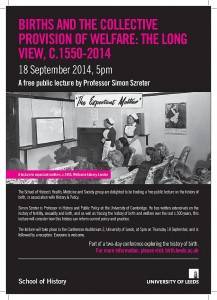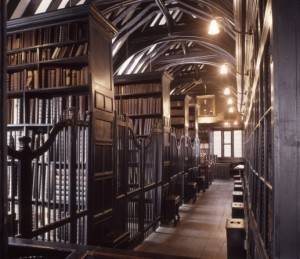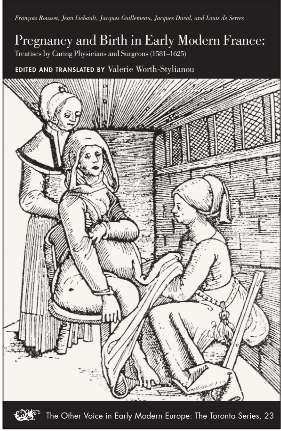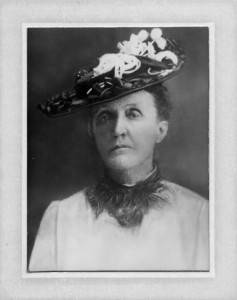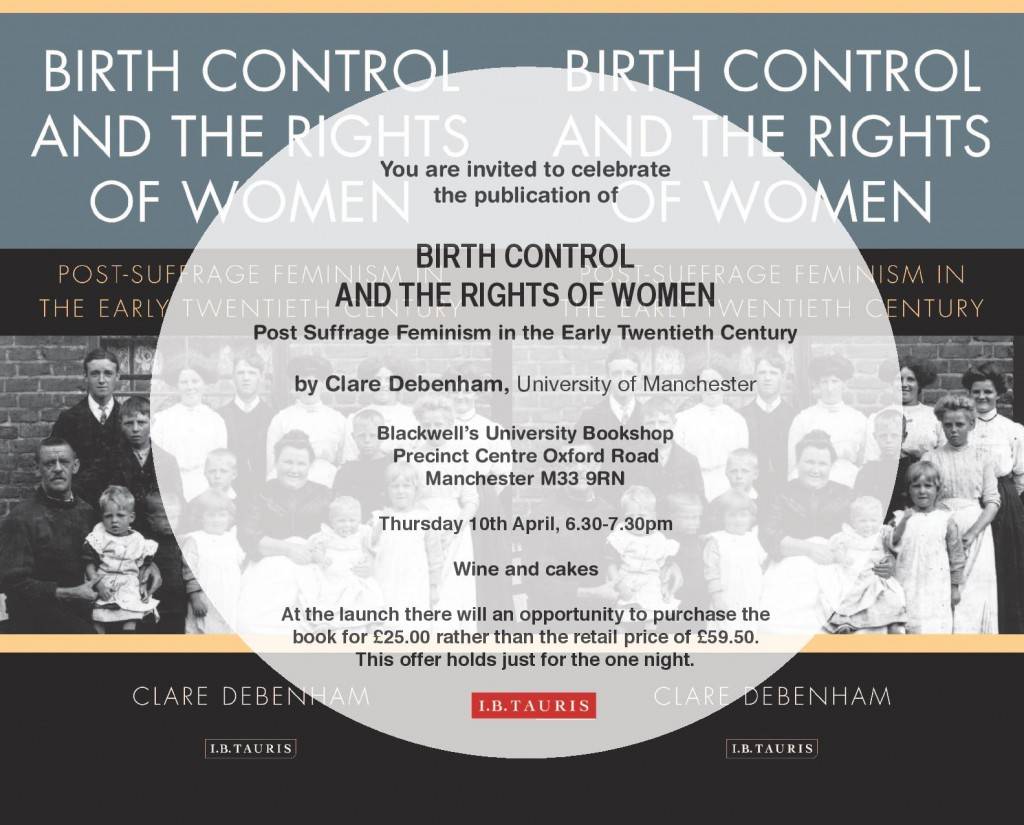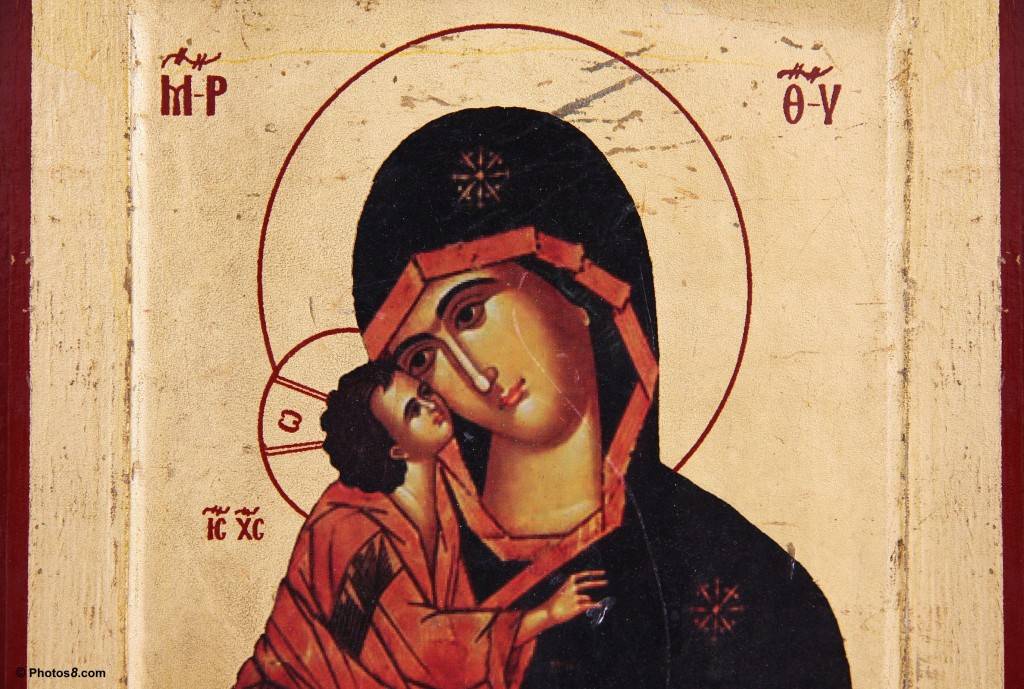Around 1900, few pregnant women in Western Europe or North America had any contact with a medical practitioner before going into labour. By the end the twentieth century, the hospitalisation of childbirth, the legalisation of abortion and a host of biomedical technologies from the Pill and IVF to obstetric ultrasound and prenatal diagnosis had dramatically extended the reach of science and medicine into human reproduction. A special issue of Studies in History and Philosophy of Biological and Biomedical Sciences published this month reflects on the social, medical and technological shifts that have shaped the experience and management of pregnancy since the turn of the twentieth century. Originating in a workshop held in Cambridge in 2012 supported by the Wellcome Trust-funded ‘Transforming Pregnancy Since 1900 project, the special issue is edited by Dr Salim Al-Gailani (University of Cambridge) and Dr Angela Davis (University of Warwick).
Author Archives: Catherine
Births and the collective provision of welfare: the long view c.1550-2014
BBC podcast: Dr Helena Wright talks to Sue MacGregor
Full text of Midwives Act 1936 now available
A scanned PDF copy of the Midwives Act 1936 can now be downloaded from the Midwives Act 1936
Birth: personal stories to population policies – conference
18th-19th September 2014, University of Leeds
This two-day conference, organised by the School of History’s Health, Medicine and Society research group, brings together those interested in the history of birth, fertility, sexuality, demography and family life, from the medieval period to the present day, and in cultures across the world. The conference aims to situate birth in the contexts of family and society, evaluate the attitudes of individuals, groups and governments to birth, explore the impact of birth, and assess changes and continuities in the experience of birth.
The conference programme includes a public lecture by Professor Simon Szreter, a keynote lecture by Professor Kate Fisher, a roundtable on the politics of procreation, and a handling session with objects from Thackray Medical Museum.
At 5pm on Thursday 18th September, we will be hosting a free public lecture by Professor Simon Szreter (University of Cambridge), in association with the History and Policy Parenting Forum. The lecture is entitled ‘Births and the collective provision of welfare – the long view c.1550-2014’, and is followed by a reception. All are welcome, and no registration is necessary.
For more information, please contact the conference organisers, Alex Bamji (a.bamji@leeds.ac.uk<mailto:a.bamji@leeds.ac.uk) and Laura King (l.king@leeds.ac.uk<mailto:l.king@leeds.ac.uk).
Laura King and Alex Bamji
Health, Medicine and Society research group
School of History
University of Leeds
Michael Sadler Building
Leeds
LS2 9JT
The next De Partu History of Childbirth event, to include a members’ meeting and the presentation of papers, will be held at the historic Chetham’s School of Music in Manchester on 14th October 2014.
More details of the programme, which includes lunch, a short guided tour of the school and a musical interlude, will follow soon.
Janette Allotey
janette.allotey@manchester.ac.uk
New book: Pregnancy and birth in early modern France
This new book may be of interest:
Pregnancy and birth in early modern France: treatises by caring physicians and surgeons (1581-1625). François Rousset, Jean Liebault, Jacques Guillemeau, Jacques Duval, and Louis de Serres. Edited and translated by Valerie Worth-Stylianou (Toronto: University of Toronto Press, 2013), ISBN Softcover 978-0-7727-2138-9; Electronic 978-0-7727-2139-6. (The electronic edition is available to institutions only.)
The flyer (hyperlinked) will allow you to purchase the book from the University of Toronto Press on its website with an early bird 20% discount should any of you be interested in ordering it for your university libraries.
Janette Allotey
School of Nursing, Midwifery and Social Work
University of Manchester
janette.allotey@manchester.ac.uk
De Partu site maintenance
The De Partu site is currently undergoing maintenance. You will notice the new background image (from Muscio, courtesy of the Wellcome Library) and new member login with the logo above. I am pleased to report that I have now identified a solution to the member login issue. The new login box (to be found at the top right-hand corner of each page) will work with the existing member logins, and includes a password reminder facility. Access to the links, archive of blog posts and tag cloud is now restricted to members. Please keep a look out in the coming weeks for additional content, including new images and the full text of the 1936 Midwives Act to accompany those of 1902 and 1918.
Catherine Ebenezer, web editor
Dr Louisa Owsley, midwife and homoeopath (Texas, late 19th century)
Book launch: Birth control and the rights of women
Reading and talking about ‘The Woman’s Book’ in Renaissance England
Medical Humanities Sheffield is proud to launch a series of open interdisciplinary lectures, for students, staff and the public.
WEDNESDAY 26 February – 6 p.m. Firth Hall
Professor Jennifer Richards
Reading and Talking about The Woman’s Book in Renaissance England
“Most written knowledge about women’s bodies” in late medieval Europe, argues Monica H. Green, “is to be found in texts composed by male physicians and surgeons, for male physicians and surgeons (or if not for them, then for lay male patrons).” This paper sets out to test this claim, exploring the reception of one popular vernacular book, Thomas Raynalde’s The Birth of Mankind; otherwise named The Womans Booke (1545-1652). There is evidence of male readers annotating their copies of this book. One annotated copy (1565) belonged to the court physician William Ward, and the marginal notes he left behind are revealing: ‘This book in any case is not to be lent [to] anye body’. However, there is also evidence that this book was in fact lent quite widely, including to and by women. This paper will explore this evidence, and try to reconstruct this book’s reading and the discussion of it, not all of which was complimentary…. It will consider what this means for the early history of women’s healthcare and female literacy.
Jennifer Richards is Professor of Early Modern Literature and Culture in the School of English Literature at Newcastle University. She has published books on rhetoric and conversation with Cambridge University Press (2003) and Routledge (2007), and many essays including on the reading of vernacular medical books in the early modern period with Journal of the History of Ideas (2012) and Bulletin of the History of Medicine (forthcoming, 2014). She is currently writing a book on shared reading in early modern England with a Leverhulme Major Research Fellowship, and, with Professor Richard Wistreich, Royal Northern College of Music, she is leading the AHRC Network ‘Voices and Books, 1500-1800’. She is an Associate Editor of the Edinburgh Companion to the Critical Medical Humanities.
Medical Humanities Sheffield
The interface between medicine and science on the one hand, and the arts and social sciences on the other hand, is one of the most exciting and important in modern academic life, offering unrivalled potential for multi-disciplinary work, policymaking, and public life. Medical Humanities Sheffield is sponsoring a series of open lectures in this exciting field.
No need to book ahead. Open to the Public.
Information related to this message is available at http://mhs.group.shef.ac.uk/.
How it became almost mandatory for dads to attend the birth
Times have changed and it is now rare that a man does not attend the birth of his baby, but how did it come to pass and could things ever change back?
BBC News article 14/03/13. by Lucy Wallis
The clinic of the birth: obstetric ultrasound, medical innovation and the clinico-anatomical project
Department of History and Philosophy of Science University of Cambridge
*** The Ninth Cambridge Wellcome Lecture in the History of Medicine ***
Thursday 16 January 2014 at 4.30pm
The clinic of the birth: obstetric ultrasound, medical innovation and the clinico-anatomical project
Malcolm Nicolson (University of Glasgow)
Ultrasonic images of the fetus are now ubiquitous. Like many innovations in medical imaging, the origins of obstetric ultrasound are often located in medical physics and engineering rather than to clinical medicine. I will argue, by contrast, for the crucial role of clinical pathology in the invention of diagnostic ultrasound. Several authors, notably Foucault in The Birth of the Clinic, have described the impact on nineteenth-century medicine of systematic correlation between lesions revealed upon dissection and signs and symptoms observed while the patient was still alive. Laboratory medicine is widely presented as having eclipsed the clinico-anatomical project in the twentieth century. This lecture will show that clinical pathology continued to inspire innovation in medical imaging after 1950. It will also argue that ultrasonic scanning is more like traditional forms of physical examination than is usually assumed.
There will be tea before the lecture, at 4pm, and a drinks reception afterwards, at 6pm.
*** Workshop ***
In addition, at 11.30am the same day Professor Nicolson will lead a discussion of a precirculated paper on James Young Simpson, the practice of gynaecological examination, and the nineteenth-century medical gaze.
Historians of gynaecology and obstetrics enjoy relating tales of the eighteenth-century man-midwife fumbling blindly under bedclothes or petticoats. Such stories serve to mark a vivid contrast between an older, backward form of practice and a reformed gynaecology led by far-sighted men like James Young Simpson, Edinburgh Professor of Midwifery and pioneer of obstetric analgesia. It is assumed that Simpson, as a disinterested scientific clinician, would have had unrestricted access to the bodies of his patients. The removal of prudish hindrances signals how far gynaecology had emancipated itself from a benighted past. However, reading Simpson, it is evident that, in mid century, the practitioner’s ability to examine female patients remained constrained by social conventions. Thus, the extent to which Simpson’s practice represents a complete departure from older modes of gynaecological work has been exaggerated. By the 1850s, the medical gaze had gained only partial and conditional access to the female body.
Regards socio-historiques sur la santé comme problème public
I am pleased to announce the following symposium:
Regards socio-historiques sur la santé comme problème public : don et transplantation d’organes, cancer, sida, dépendance au jeu et santé mentale [Historical and sociological perspectives on health as a public problem: organ donation, cancer, AIDS, gambling addiction and mental health].
This symposium will be held in French, on February 13th, 2014, at the University Institute of the History of Medicine and Public Health at Lausanne, Switzerland.
For any queries, please contact: raphael.hammer@hesav.ch
Best wishes
Raphaël Hammer
University of Health Sciences (HESAV), Institute of Health Research, University of Applied Sciences and Arts, Wester Switzerland (HES-SO)
1011 Lausanne
Switzerland
Raphaël HAMMER, Professeur HES-S2, Av. de Beaumont 21, 1011 Lausanne
t : +41 21 316 81 19
raphael.hammer@hesav.ch
www.hesav.ch

